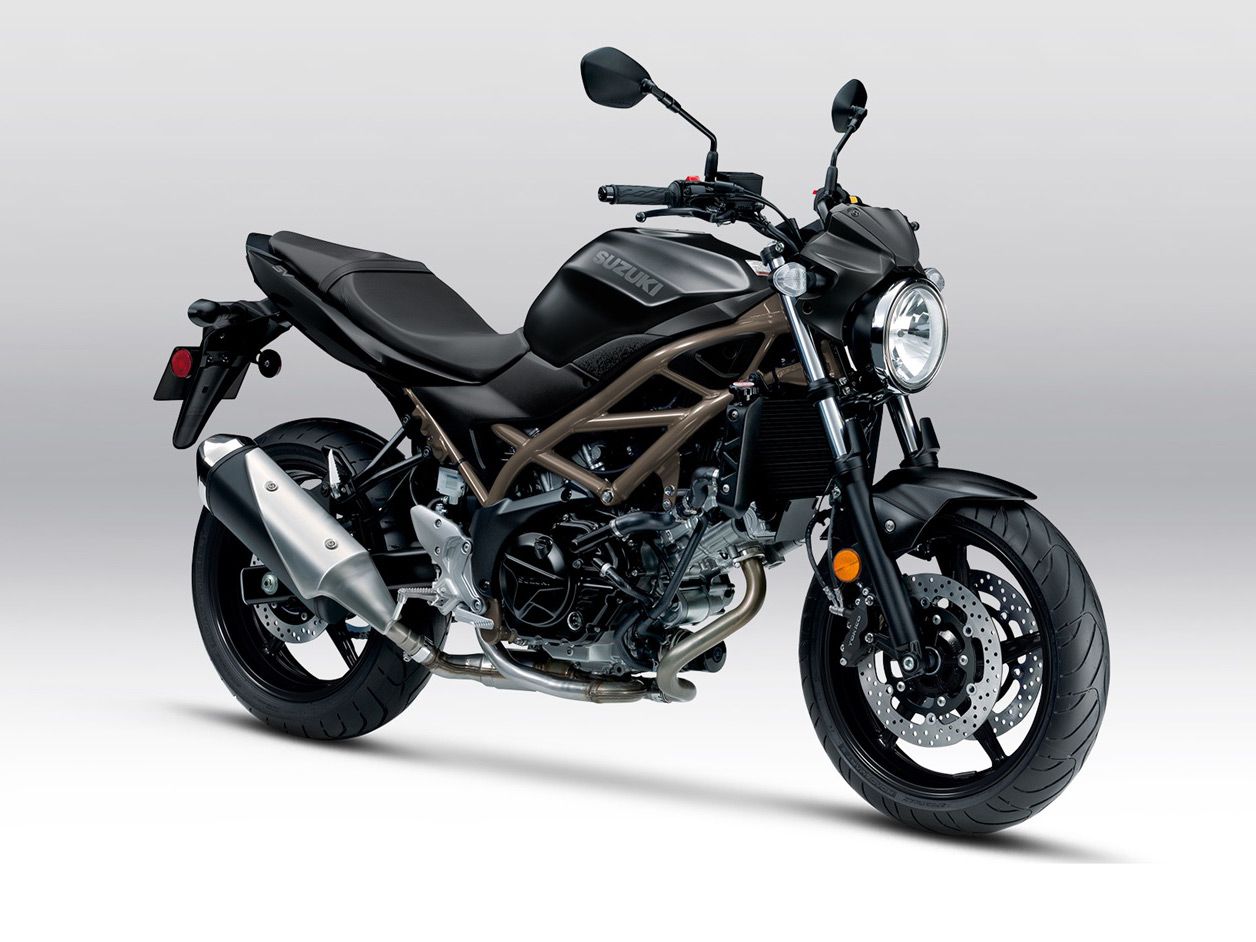
Ups
- Unique-for-its-class V-twin engine
- Attractive price tag
- Narrow seat
- Great sound
- Tried-and-true design
Downs
- Tried-and-true design means no significant updates in recent years
- Below-average front brake performance
- Heavier than a majority of its competitors
Verdict
For those looking for a great first, second, or even one-and-only bike, the SV650 is a great bet. Today’s crop of competitors puts serious pressure on this proven platform, but the current SV remains true to its roots as a straightforward, simple, charismatic, and capable all-arounder.
Overview
The Suzuki SV650 is an iconic V-twin-powered middleweight. When it entered the fray in 1999, it set a high bar for standard motorcycles everywhere, because it did everything well and seemed to love it. The SV happily served everyone from first-timers to old-timers, many of whom kept them on as long-timers. It’s the rare motorcycle that can be both a first and a forever bike.
While it was wonderfully successful in its first few years, the SV650 unfortunately lost loyal fans when it was restyled and redesigned as the Gladius and SFV650 in 2009 and 2013, respectively. These bikes were heavier and decked out in bodywork that might charitably be called “funky.” Fortunately, it made a comeback in 2017, and got a tasteful follow-up in 2019 with the addition of the cafe-styled SV650X. The revised standard had returned to its roots, and was approachable, straightforward, and most of all, fun.
Since its return to the tried-and-true design, the SV has introduced a new generation of enthusiasts to its combination of peppy, character-rich V-twin power and agile but predictable road manners. That combo makes it both a highly capable and entertaining commuter and a fun canyon carver.
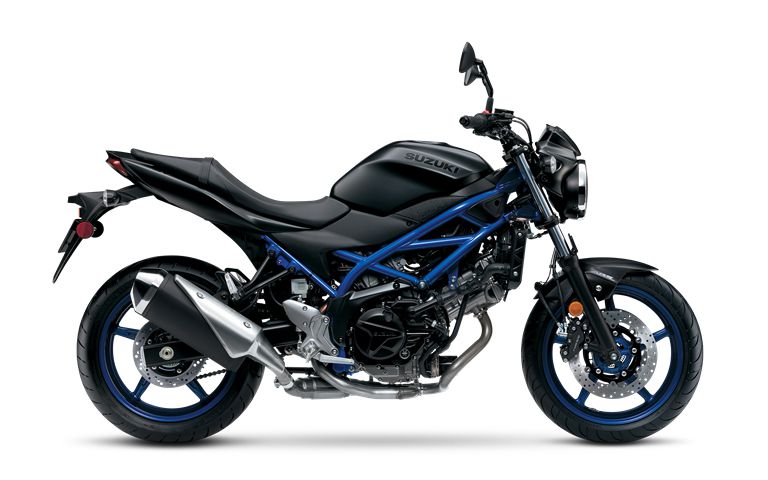
Updates for 2022
Why mess with success again? Suzuki learned its lesson the first time. Maybe a little too well, as the SV650 hasn’t seen a major update in years.
Pricing and Variants
The SV650 is available with or without ABS ($7,749/$7,299).
Competition
Middleweight standards from around the world are coming at the Suzuki in droves. This includes three options from Japan and two from Europe: Yamaha’s MT-07, Kawasaki’s Z650, Honda’s CB650R, Triumph’s Trident 660, and Aprilia’s Tuono 660.
One thing to consider here is that the majority of the competition is powered by parallel-twin engines, with only the Honda CB650R using a four. Suzuki’s V-twin gives it a notably different character, not to mention a much better sound.
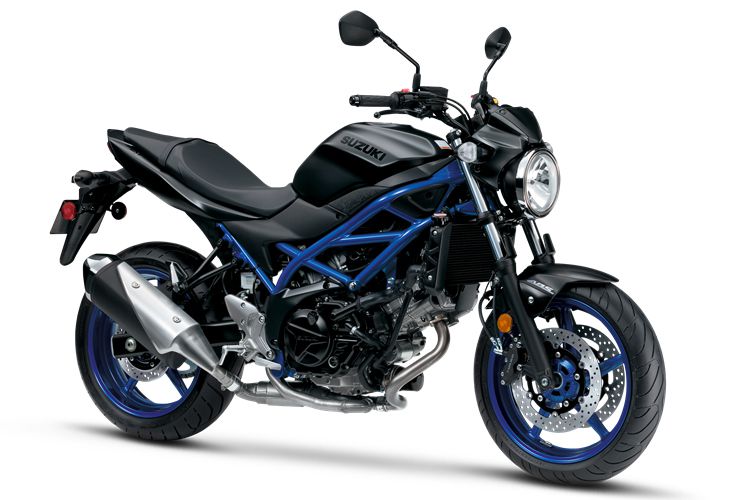
Powertrain: Engine, Transmission, and Performance
The SV650′s proven 645cc V-twin engine has plenty of low- to midrange power for passing traffic, pulling smoothly to its 10,000 rpm redline. In other words, there’s plenty of room to stretch the engine’s legs at higher speeds. The intake and 2-into-1 exhaust also give fantastic tones. In our past review, the engine “displayed the epitome of perfect fueling, sweet gearbox action, and easily managed throttle response.”
A useful feature for new riders is the bike’s low-rpm assist, which adjusts engine speed to help prevent stalling during takeoff. Startup is also an easy task; with a single press of a button, the Easy Start System runs the motor until the bike fires up. No need to pull in the clutch if the bike’s in neutral; make use of the free hand to adjust the mirrors, close your visor, or whatever, as the bike springs to life.
Producing a measured 69.3 hp at 8,530 rpm meant it produced more peak horsepower than its 2017 rivals, but today, peak horsepower figures for middleweights is up in the 70–80 range (we’re looking at you Trident 660, CB650R, and Tuono 660).
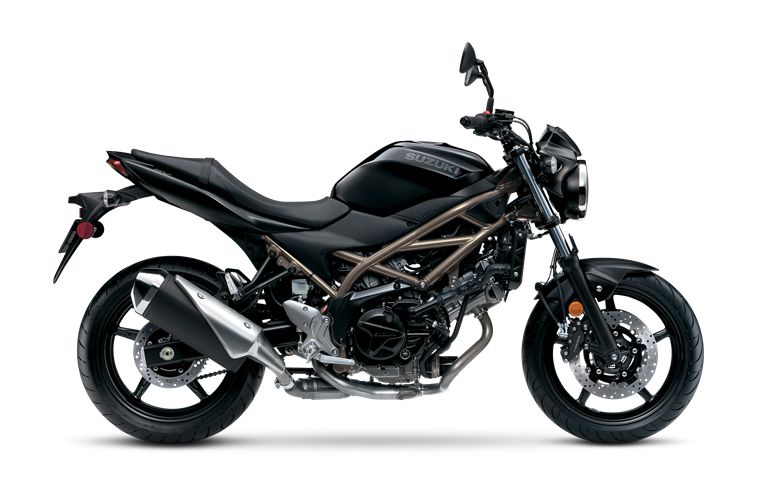
Handling
At a claimed 437 pounds, today’s ABS-equipped model is about 8 pounds lighter than the previous-generation SFV650, but 20 or more pounds heavier than current competitors, with the exception of the CB650R. Although this impacts agility somewhat, it aids in overall stability. In an earlier comparison with the Kawasaki Z650 and Yamaha FZ-07, Cycle World commented, “The SV650′s mellowed yet relatable charm is more apparent on the road. It’s not the lightest-handling bike in the group, but it’s the most stable, predictable, and planted on a twisting canyon road and feels totally refined.”
Suspension is handled by a telescopic fork and link-type rear shock for a firm and sporty ride. These components are nonadjustable, with the exception of preload at the rear.
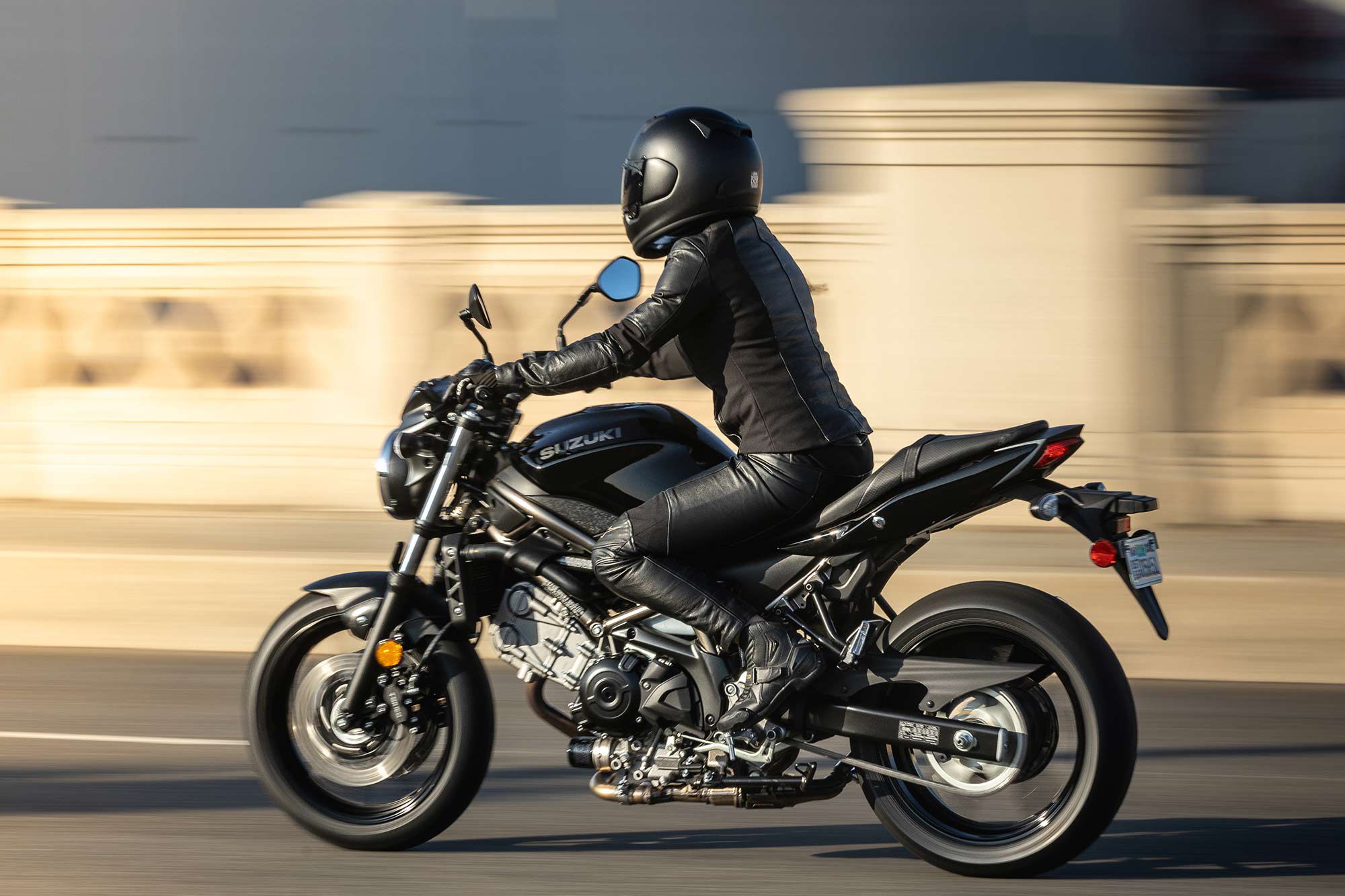
Brakes
Braking is handled by two four-piston Tokico calipers and a pair of 290mm floating stainless steel discs up front and a single one-piston caliper and 240mm disc out back. These contribute to good stopping power; however, we found the two front units lacking in bite and power, with numb feedback overall.
Testing the brakes against its 2017 competition showed that the SV needed more room to come to a stop. From 60–0, the SV stopped in 139 feet, which isn’t bad, but the FZ-07 and Z650 did it in 136 and 132 feet.
Fuel Economy and Real-World MPG
We averaged 48 mpg during our testing. This was right in between the FZ-07 (51 mpg) and Z650 (47 mpg).
Ergonomics: Comfort and Utility
The SV650′s ergonomics are relaxed and comfortable. The point where the seat and tank meet is narrow and the handlebar is wide. It is relatively heavy, but the seat height is an admirably low 30.9 inches which makes keeping the bike upright at stops doable.
Although extended periods of time on the seat may cause discomfort, the overall riding position is neutral enough to make it an all-around comfortable commuter and weekend ride.
Electronics
Starting up the SV is a simple affair. The Easy Start System only requires a short press of the starter button while the bike is in neutral in order for the bike to come to life. Pulling in the clutch is not necessary.
A basic LCD display, halogen headlight, and LED taillight are standard; ABS is a $450 option.
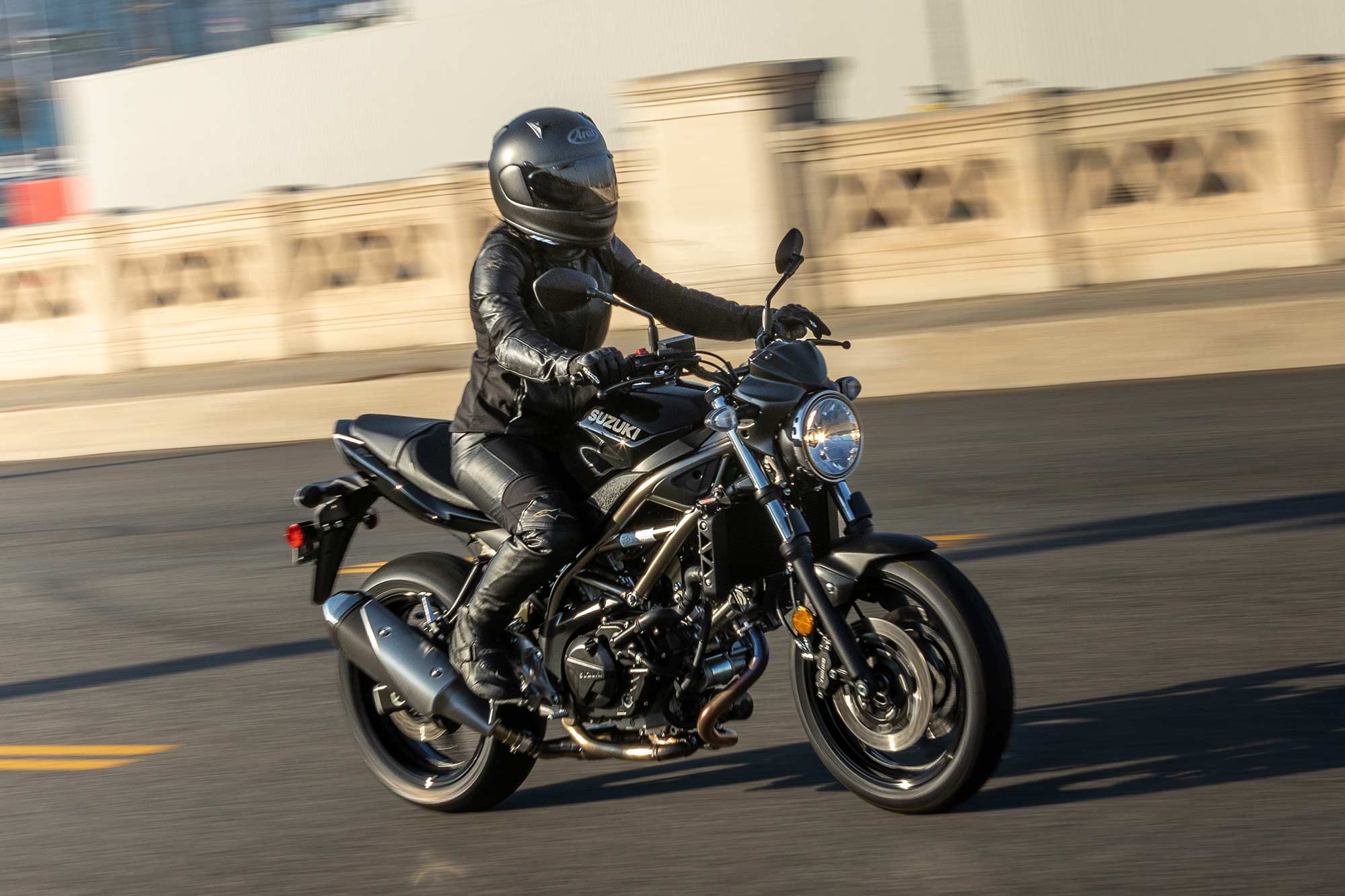
Warranty and Maintenance Coverage
Suzuki offers a one-year limited warranty for the SV650 with the option to extend with Suzuki’s Extended Protection plan.
Quality
Although, or perhaps because, this Suzuki hasn’t had a recent update and the components are no longer cutting-edge, this bike is ridiculously reliable.
2022 Suzuki SV650/ABS Claimed Specifications
| MSRP: | $7,299 (non-ABS)/$7,749 (ABS) |
| Engine: | 645cc, DOHC, liquid-cooled V-twin |
| Bore x Stroke: | 81.0 x 62.6mm |
| Transmission/Final Drive: | 6-speed/chain |
| Cycle World Measured Horsepower: | 69.3 hp @ 8,530 rpm |
| Cycle World Measured Torque: | 44.2 lb.-ft. @ 8,000 rpm |
| Fuel Delivery: | Electronic fuel injection |
| Clutch: | Wet, multiplate |
| Engine Management/Ignition: | Engine control module/electronic transistorized |
| Frame: | Steel trellis |
| Front Suspension: | 41mm telescopic fork; 4.9 in. travel |
| Rear Suspension: | Link-type shock, preload adjustable; 2.5 in. travel |
| Front Brake: | Dual 4-piston Tokico calipers, full-floating 290mm discs w/ ABS (optional) |
| Rear Brake: | 1-piston caliper, 240mm disc w/ ABS (optional) |
| Wheels, Front/Rear: | Cast aluminum; 17 in. / 17 in. |
| Tires, Front/Rear: | 120/70-17 / 160/60-17 |
| Rake/Trail: | 25.0°/4.1 in. |
| Wheelbase: | 56.9 in. |
| Ground Clearance: | 5.3 in. |
| Seat Height: | 30.9 in. |
| Fuel Capacity: | 3.8 gal. |
| Claimed Wet Weight: | 432 lb. (non-ABS) / 437 lb. (ABS) |
| Contact: | suzukicycles.com |
Source: MotorCyclistOnline.com
